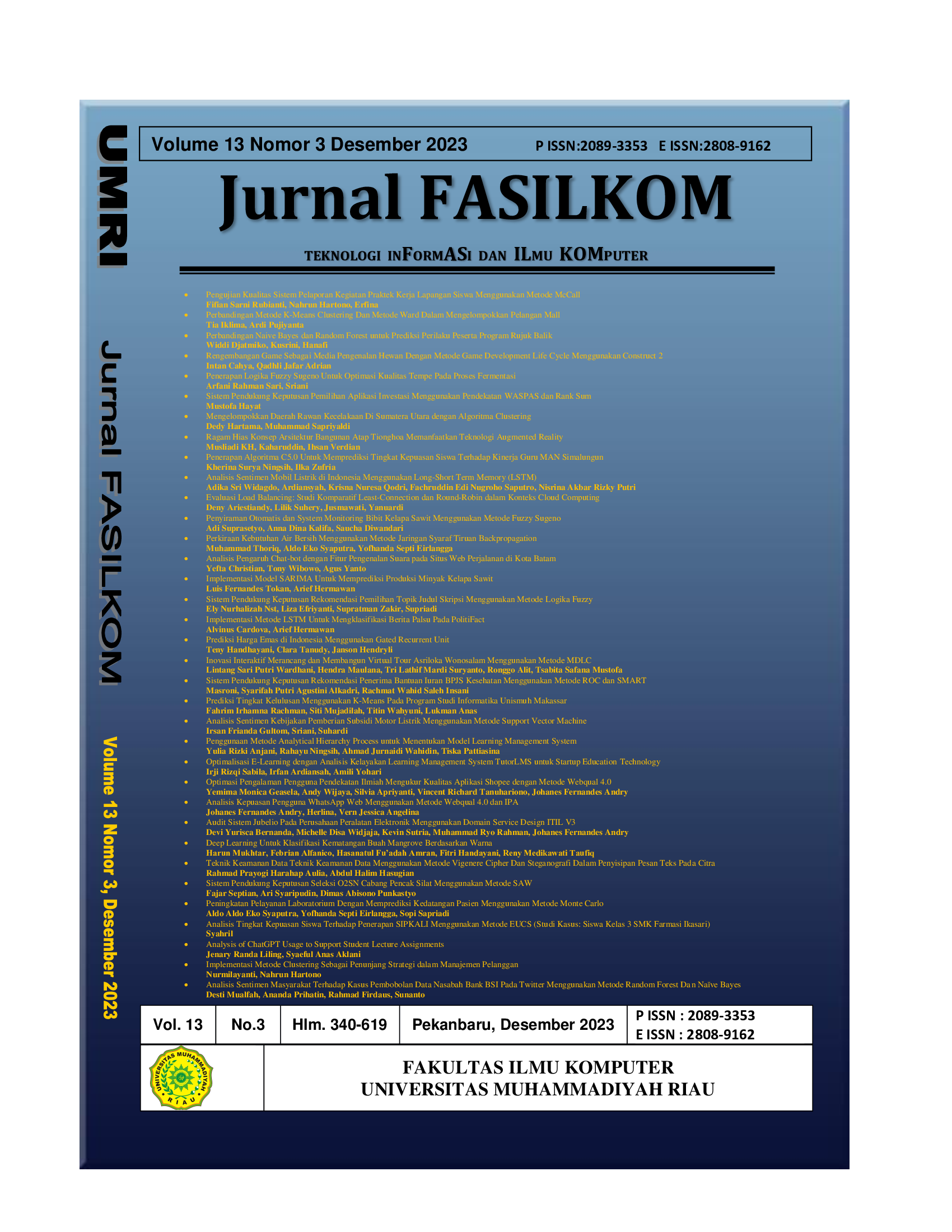Analisis Kepuasan Pengguna WhatsApp Web Menggunakan Metode Webqual 4.0 dan IPA
DOI:
 https://doi.org/10.37859/jf.v13i3.5945
https://doi.org/10.37859/jf.v13i3.5945
Abstract
Social media has become a lifestyle that cannot be ignored in recent times. One of the most frequently used online communication tools today is WhatsApp, which was created in 2009 by Jan Koum. In Indonesia, this application is used by all groups ranging from young and old, students to workers / employees who indirectly WhatsApp is a social media that has many advantages to become quite important in everyday life in society. The emergence of WhatsApp Web is a technology that gives its users the freedom to use more than one device, so that it can attract more users to use it. With so many users, researchers want to know how user satisfaction from this website regarding its usability, appearance, and service quality. Of course, to analyze the research, several methods are needed so that the analysis can run well. This research integrates the WebQual 4.0 and Importance Performance Analysis methods as a data analysis process. Researchers also used a questionnaire as a way to collect data from WhatsApp Web users, the questionnaire consisted of 23 questions with two indicators of expectations and performance. The results of this study are that there is a good influence from Usability Quality and Services Interaction Quality on user satisfaction and another case with Information Quality which has no effect. The recommendation for users is that WhatsApp Web cannot be accessed via a browser on a PC or laptop, it is possible that there is a VPN (Virtual Private Network) application, this application must be deactivated first.
Downloads
References
J. Gaglani, Y. Gandhi, S. Gogate, and A. Halbe, 2020, Unsupervised WhatsApp Fake News Detection using Semantic Search, Proc. Int. Conf. Intell. Comput. Control Syst. ICICCS 2020, no. Iciccs, pp. 285–289. doi: 10.1109/ICICCS48265.2020.9120902.
M. N. Fikri, 2022, Pengembangan Aplikasi Bot Whatsapp Untuk Sistem Notifikasi Menggunakan Metode Waterfall, Univ. Negri Jogja.
C. M. Annur, 2022, WhatsApp, Aplikasi Pesan Instan Paling Banyak Digunakan di Dunia, Databooks.
B. Dean, 2022, WhatsApp 2022 User Statistics: How Many People Use WhatsApp?, Backlinko.
B. Stegner, 2021, What Is WhatsApp, and Why Is It So Popular?, Make Use.
M. Muskita, 2020, ‘Efektivitas Pemanfaatan Aplikasi Whatsapp Dalam Pengambilan Keputusan Redaksi’ (Studi : Redaksional Harian Rakyat Maluku), Badati, vol. 2, no. 1, pp. 85–97. doi: 10.38012/jb.v2i1.409.
S. Ramraj, 2021, Signature Identi cation and User Activity Analysis on Whatsapp Web through Network Data.
S. Supriyanto and D. Trijayanto, 2021, Efektivitas Pemanfaatan Aplikasi Whatsapp Sebagai Media Komunikasi Penunjang Kinerja pada Karyawan PT. Flexindo, Promedia (Public Relat. Dan Media Komunikasi), vol. 7, no. 1, pp. 42–78. doi: 10.52447/promedia.v7i1.4568.
N. V. Vukadinovic, 2019, WhatsApp Forensics: Locating Artifacts in Web and Desktop Clients, Master’s Thesis, Purdue Univ. Grad. Sch..
I. H. Mu’minah and M. K. Sugandi, 2021, Pemanfaatan Aplikasi Whatsapp Group Sebagai Media Pembelajaran Daring Pada Masa Pandemi Covid-19, J. Bio Educ., vol. 6, pp. 68–81.
Trisnani, 2017, Pemanfaatan Whatsapp Sebagai Media Komunikasi Dan Kepuasan Dalam Penyampaian Pesan Dikalangan Tokoh Masyarakat, J. Komunika J. Komunikasi, Media dan Inform., vol. 6, no. 3, doi: 10.31504/komunika.v6i3.1227.
S. N. Botutihe, M. Bin Smith, I. A. Kasan, and R. Hilala, 2020, Strategi Pembelajaran Physical Distancing Guru PAUD dalam Menghadapi Pandemi Covid19, J. Obs. J. Pendidik. Anak Usia Dini, vol. 5, no. 2, pp. 1536–1543. doi: 10.31004/obsesi.v5i2.919.
Rahartri, 2019, ‘Whatsapp’ Media Komunikasi Efektif Masa Kini (Studi Kasus Pada Layanan Jasa Informasi Ilmiah di Kawasan PUSPIPTEK) Pusat Data dan Dokumentasi Ilmiah - Lembaga Ilmu Pengetahuan Indonesia, Visi Pustaka, vol. 21, no. 2, pp. 147–156.
R. Agüero, T. Zinner, M. Garcia-Lozano, B. L. Wenning, and A. Timm-Giel, 2016, Editorial: Mobile Networks and Management, vol. 21, no. 4.
E. Alfarizi, Moh Khory; Prima, 2021, Masalah Sinkronisasi, WhatsApp Perbarui Fitur Multi-Perangkat,” Tekno.
D. Diana and N. D. M. Veronika, 2018, Analisis Kualitas Website Provinsi Bengkulu Menggunakan Metode Webqual 4.0,” Pseudocode, vol. 5, no. 1, pp. 10–17. doi: 10.33369/pseudocode.5.1.10-17.
Jamaludin, 2018, Analisa Perhitungan dan Pemilihan Load Cell pada Rancang Bangun Alat Uji Tarik Kapasitas 3 Ton,” vol. 2, no. 2, pp. 1–23.
D. Pesch, A. Timm-giel, and D. Ferrari, 2017, Mobile Networks and Management, vol. 191, no. September.
S. Okvireslian, 2021, Pemanfaatan Aplikasi Whatsapp Sebagai Media Pembelajaran Dalam Jaringan Kepada Peserta Didik Paket B Uptd Spnf Skb Kota Cimahi,” Comm-Edu (Community Educ. Journal), vol. 4, no. 3, p. 131. doi: 10.22460/comm-edu.v4i3.7220.
I. S. Utami, Winarno, and H. Setiadi, 2021, Analysis the Effect of Website Quality on User Satisfaction with the WebQual 4.0 Method and Importance-Performance Analysis (IPA) (Case Study: SPMB Sebelas Maret University’s Website),” J. Phys. Conf. Ser., vol. 1842, no. 1, pp. 0–8. doi: 10.1088/1742-6596/1842/1/012003.
M. L. Jundillah, J. E. Suseno, and B. Surarso, 2019, Evaluation of E-learning Websites Using the Webqual Method and Importance Performance Analysis, E3S Web Conf., vol. 125, no. 201 9, pp. 1–5. doi: 10.1051/e3sconf/201912524001.
W. S. Fatmala, Suprapto, and A. Rachmadi, 2018, Analisis kualitas layanan website e-commerce berrybenka terhadap kepuasan pengunjung menggunakan metode webqual 4.0 dan importance performance analysis (ipa), J. Pengemb. Teknol. Inf. dan Ilmu Komput., vol. 2, no. 1, pp. 175–183.
F. Rindani and S. Puspitodjati, 2020, Integration of Webqual Method to Importance Performance Analysis and Kano Model to Analyze System Quality of E-Government: Case Study LAPOR!, J. Sist. Inf., vol. 16, no. 2, pp. 1–17. doi: 10.21609/jsi.v16i2.937.
A. Ibrahim, F. S. Elisa, J. Fernando, L. Salsabila, N. Anggraini, and S. N. Arafah, 2021, Pengaruh E-Service Quality Terhadap Loyalitas Pengguna Aplikasi MyTelkomsel, Build. Informatics, Technol. Sci., vol. 3, no. 3, pp. 302–311, Dec. doi: 10.47065/bits.v3i3.1076.
H. Siagian and E. Cahyono, 2014, Analisis Website Quality, Trust Dan Loyalty Pelanggan Online Shop,” J. Manaj. Pemasar., vol. 8, no. 2, pp. 55–61. doi: 10.9744/pemasaran.8.2.55-61.
C. Prasetyawan, 2021, Pengaruh Experimential Marketing, Kualitas Pelayanan, dan Nilai Pelanggan Terhadap Kepuasan Konsumen (Survei Pada Pelanggan Goodboy Barbershop Ponorogo), J. Adm. Bisnis Fisipol Unmul, vol. 9, no. 4, p. 276. doi: 10.54144/jadbis.v9i4.6361.
Herlina and D. Widyaningrum, 2023, Investigating User Acceptance of Fintech Paylater with Technology Acceptance Model (TAM), J. Teknol. Inf., vol. 7, no. 1, 2023, Accessed: Sep. 05. [Online]. Available: http://www.jurnal.una.ac.id/index.php/jurti/article/viewFile/3481/2538.
J. A. Kadar, D. Napitupulu, and R. K. Jati, 2017, Analysis of factors influencing the quality of intranet website based on WebQual approach case study in agency X, Proceeding - 2017 3rd Int. Conf. Sci. Inf. Technol. Theory Appl. IT Educ. Ind. Soc. Big Data Era, ICSITech 2017, vol. 2018-Janua, pp. 526–532. doi: 10.1109/ICSITech.2017.8257169.
C. H. Liao, 2015, Exploring the impacts of age and usage experience of e-service on user perceived web quality, Lect. Notes Comput. Sci. (including Subser. Lect. Notes Artif. Intell. Lect. Notes Bioinformatics), vol. 9193, pp. 230–238. doi: 10.1007/978-3-319-20892-3_23.
J. F. Andry, K. Christianto, and F. R. Wilujeng, 2019, Using Webqual 4.0 and Importance Performance Analysis to Evaluate E-Commerce Website, J. Inf. Syst. Eng. Bus. Intell., vol. 5, no. 1, p. 23. doi: 10.20473/jisebi.5.1.23-31.
Herlina, D. Widyaningrum, and G. Theotista, 2023, Tipologi Financial Technology Paylater : Technology Acceptance Model ( TAM ) Tipologi Financial Technology Paylater : Model Penerimaan Teknologi (TAM), Formosa J. Multidiscip. Res., vol. 2, no. 1, pp. 207–216.
J. F. Andry, Herlina, and A. Rianto, 2023, Customer Satisfaction Analysis on Shopee E-Commerce Using the UTAUT Method, Cogito Smart J. |, vol. 9, no. 1, 2023, Accessed: Jul. 07. [Online]. Available: https://cogito.unklab.ac.id/index.php/cogito/article/view/454/273.
Downloads
Published
Issue
Section
License
Copyright Notice
An author who publishes in the Jurnal FASILKOM (teknologi inFormASi dan ILmu KOMputer) agrees to the following terms:
- Author retains the copyright and grants the journal the right of first publication of the work simultaneously licensed under the Creative Commons Attribution-ShareAlike 4.0 License that allows others to share the work with an acknowledgement of the work's authorship and initial publication in this journal
- Author is able to enter into separate, additional contractual arrangements for the non-exclusive distribution of the journal's published version of the work (e.g., post it to an institutional repository or publish it in a book) with the acknowledgement of its initial publication in this journal.
- Author is permitted and encouraged to post his/her work online (e.g., in institutional repositories or on their website) prior to and during the submission process, as it can lead to productive exchanges, as well as earlier and greater citation of the published work (See The Effect of Open Access).
Read more about the Creative Commons Attribution-ShareAlike 4.0 Licence here: https://creativecommons.org/licenses/by-sa/4.0/.












_(1).png)





